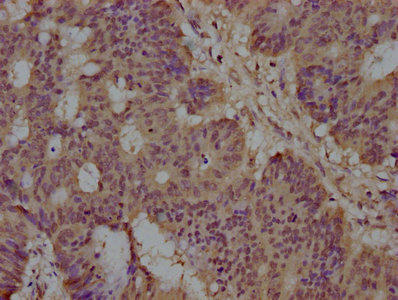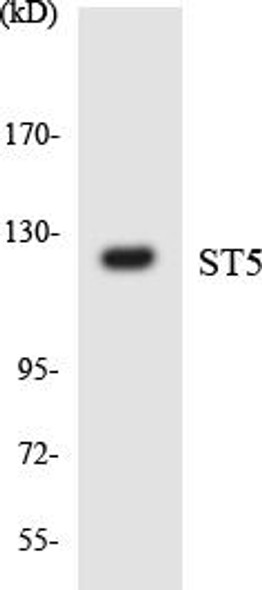Description
ST5 Antibody (PACO63711)
The ST5 Polyclonal Antibody (PAC063711) is a valuable tool for research involving the ST5 protein, a key player in signal transduction pathways and cellular processes. This antibody, generated in rabbits, exhibits high specificity and sensitivity in detecting ST5 in human samples, making it ideal for use in Western blot applications. By binding to the ST5 protein, researchers can accurately analyze and study its expression and function in various cell types.ST5, also known as suppression of tumorigenicity 5, is involved in regulating cell growth, proliferation, and survival, making it a crucial target for cancer research and drug development. Its role in modulating signaling cascades and gene expression pathways highlights its importance in cellular behavior and disease progression.
Understanding the mechanisms underlying ST5 function can provide valuable insights into potential therapeutic strategies for cancer and other related disorders.Utilizing the ST5 Polyclonal Antibody in research settings can help uncover the intricate role of ST5 in cellular physiology and disease pathogenesis, ultimately driving advancements in cancer biology and personalized medicine. Its reliability and versatility make it a valuable asset for scientists studying signal transduction pathways and exploring potential therapeutic targets in various pathological conditions.
| Antibody Name: | ST5 Antibody (PACO63711) |
| Antibody SKU: | PACO63711 |
| Size: | 50ul |
| Host Species: | Rabbit |
| Tested Applications: | ELISA, IHC |
| Recommended Dilutions: | ELISA:1:2000-1:10000, IHC:1:20-1:200 |
| Species Reactivity: | Human |
| Immunogen: | Peptide sequence from Human Suppression of tumorigenicity 5 protein (68-88AA) |
| Form: | Liquid |
| Storage Buffer: | Preservative: 0.03% Proclin 300 Constituents: 50% Glycerol, 0.01M PBS, pH 7.4 |
| Purification Method: | Antigen Affinity Purified |
| Clonality: | Polyclonal |
| Isotype: | IgG |
| Conjugate: | Non-conjugated |
 | IHC image of PACO63711 diluted at 1:100 and staining in paraffin-embedded human colon cancer performed on a Leica BondTM system. After dewaxing and hydration, antigen retrieval was mediated by high pressure in a citrate buffer (pH 6.0). Section was blocked with 10% normal goat serum 30min at RT. Then primary antibody (1% BSA) was incubated at 4°C overnight. The primary is detected by a biotinylated secondary antibody and visualized using an HRP conjugated SP system. |
| Background: | Guanine nucleotide exchange factor (GEF) which may activate RAB9A and RAB9B. Promotes the exchange of GDP to GTP, converting inactive GDP-bound Rab proteins into their active GTP-bound form. May be involved in cytoskeletal organization and tumorogenicity. Isoform 1 seems to be involved in a signaling transduction pathway leading to activation of MAPK1/ERK2. Isoform 3 may block ERK2 activation stimulated by ABL1. Isoform 3 may alter cell morphology and cell growth. |
| Synonyms: | Suppression of tumorigenicity 5 protein (DENN domain-containing protein 2B) (HeLa tumor suppression 1), ST5, DENND2B HTS1 |
| UniProt Protein Function: | DENND2B: a guanine nucleotide exchange factor (GEF) that may activate RAB9A and RAB9B. May be involved in cytoskeletal organization and tumorogenicity. Widely expressed with the exception of peripheral blood lymphocytes and lymphoid cell lines. 3 isoforms of the human protein are produced by alternative promoter. Isoform 1 interacts with the SH3 domain of ABL1, is expressed in several epithelial, fibroblast, and tumorigenic cell lines, and seems to be involved in the activation of ERK2. Isoform 3, expressed in primary cells that may be weakly tumorigenic, but not in tumorigenic cell lines, may block ERK2 activation stimulated by ABL1, and may alter cell morphology and cell growth. |
| UniProt Protein Details: | Protein type:GEFs; GEFs, Rab Chromosomal Location of Human Ortholog: 11p15 Molecular Function:Rab guanyl-nucleotide exchange factor activity |
| NCBI Summary: | This gene was identified by its ability to suppress the tumorigenicity of Hela cells in nude mice. The protein encoded by this gene contains a C-terminal region that shares similarity with the Rab 3 family of small GTP binding proteins. This protein preferentially binds to the SH3 domain of c-Abl kinase, and acts as a regulator of MAPK1/ERK2 kinase, which may contribute to its ability to reduce the tumorigenic phenotype in cells. Three alternatively spliced transcript variants of this gene encoding distinct isoforms are identified. [provided by RefSeq, Jul 2008] |
| UniProt Code: | P78524 |
| NCBI GenInfo Identifier: | 317373507 |
| NCBI Gene ID: | 6764 |
| NCBI Accession: | P78524.3 |
| UniProt Secondary Accession: | P78524,P78523, Q16492, Q7KYY2, Q7KZ12, Q8NE12, Q9BQQ6 B2R6X7, B3KXQ6, |
| UniProt Related Accession: | P78524 |
| Molecular Weight: | 70,245 Da |
| NCBI Full Name: | Suppression of tumorigenicity 5 protein |
| NCBI Synonym Full Names: | suppression of tumorigenicity 5 |
| NCBI Official Symbol: | ST5 |
| NCBI Official Synonym Symbols: | HTS1; p126; DENND2B |
| NCBI Protein Information: | suppression of tumorigenicity 5 protein; heLa tumor suppression 1; DENN/MADD domain containing 2B |
| UniProt Protein Name: | Suppression of tumorigenicity 5 protein |
| UniProt Synonym Protein Names: | DENN domain-containing protein 2B; HeLa tumor suppression 1 |
| Protein Family: | Suppression of tumorigenicity 5 protein |
| UniProt Gene Name: | ST5 |
| UniProt Entry Name: | ST5_HUMAN |












